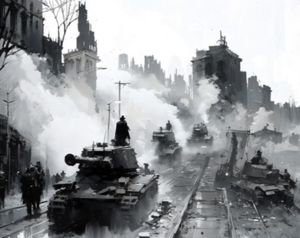The Astrian Civil War 1986 - 1993
| Astrian Civil War | |||||||
|---|---|---|---|---|---|---|---|
 Tanks rolling past ruins during the Siege of Doldister | |||||||
| |||||||
| Loyalists-Revolutionaries | |||||||
|
Loyalists |
Revolutionaries | ||||||
| Commanders and leaders | |||||||
|
|
| ||||||
| Strength | |||||||
|
In 1986
In 1993
|
In 1986
In 1993
| ||||||
| Casualties and losses | |||||||
|
|
| ||||||
|
Civilian Dead 296,000 Civilian Injured 361,000 | |||||||
| |||||||
The Astrian Civil War was a conflict lasting from 1986 - 1993, revolving around multiple factions that sought both reform or revolution. The monarchy of Astrium had grown politically unpopular, as King Fredrick III's administration proved incapable of protecting the people from natural disasters, economic meltdown and terrorist attacks. His son, Fredrick IV, was initially viewed as a reformer, though these hopes were dashed, as the new King emulated his father in policy. Corruption spiralled, and nepotism in both government and corporations thrived openly. With reforms blocked by the King's officials, educated resistance began campaigns to spread awareness and seek popular consent for the abolition of monarchy. The nascent republican movement grew in tandem with more hard-left factions, including anarchists and Communists. In 1986, the Parliament, holding within the King and his High Minister Lord Adam Falstirm, was bombed successfully by revolutionaries. With the the government leaderless, the Kingdom fell into anarchy, with various cliques arranged broadly into loyalists and revolutionaries, though significant inter-factional rivalries also caused small scale conflicts. The loyalists ultimately emerged victorious following a brutal campaign, leaving hundreds of thousands dead in their wake.
Causes of the conflict
The Revolutionaries had been increasingly disturbed by Fredrick III and his son Fredrick IV for being useless on the world stage and at home. Fredrick III had consistently failed at assisting the people during famines, natural disasters and when terror attacks rocked the capital. Subjects all over the kingdom had begun to wish for a new dawn when Fredrick IV took the throne, but when they saw an identical reign of Fredrick IV's approaching, despair and hopelessness surrounded the kingdom. A new light had emerged from the darkness, a possibility of a new King for some, a new country for others.
During April of 1986 the communists and Republicans had grown to be more popular than the government therefore, protests, demonstrations, and riots fell upon major cities and population centres across the kingdom. On April 13th 1986 protests began in the centre of Doldister, Communists, Anarchists, and Republicans had gathered in their own sections of the city to start demonstrating against the King and his government. Slowly through the days and nights of the longest unrest the kingdom had seen, the protesters became more violent and unsatisfied with the stubbornness of the government. Therefore on the night of April 17th the protests had turned to riots, destruction of government institution buildings and surrounding areas prompted the King to send in the Armed Forces to quell riots. However, this only made the rioters more furious and progressed towards the parliament building, where King Fredrick IV and the High Minister, Adam Falstirm, were staying along with many delegates from across the kingdom.
Throughout the final day of riots on April 19th 1986, the rioters had gathered around the parliament building of Astrium, armed with Molotov cocktails, poles to beat people and police, and a few with explosives and guns. In the evening of that day rioters stormed the building and forced their way to the main room, where the most important leaders of the Kingdom were. While the rioters had burst in, one threw and detonated an explosive device that resulted the collapse of the celling, crushing many of those inside of the chamber, recorded inside of the building the deaths of the King, High Minister, and 127 Councillors were accounted. Soon after this explosion was noticed inside the parliament building, the police and Armed Forces opened fire into one of the crowds, therefore the protesters and rioters with weapons retaliated.
Protests around the city had also devolved into violence and with the news of the killing of the King, spiralled even further into armed combat between two sides. While the days moved on with no end to fighting in and around the capital, armed revolts had sprung up all over the country, with leaders taking their place and creating organised armies. Therefore by the 24th of April a full scale civil war had begun with Loyalists wishing to keep the monarchy in power and the Revolutionaries attempting to tear apart the old government of the Kingdom.
The explosion inside of the parliament building that killed King Fredrick IV, High Minister Lord Adam Falstirm, and many other councillors is seen as the starting event of the Astrian Civil War where from there the two sides organised themselves into armies and factions.
Foreign Intervention
Overseas, the Astrian Civil War was viewed as an open proxy war primarily between Celesterra, and the Great Zhi, with Celesterran support being vital the loyalist victory, while the Great Zhi opportunistically backed the Republicans. This caused significant political turmoil within the Imperial aristocracy, and tension between the Republicans and their benefactors. The government of the Anguang Emperor was heavily criticised by conservatives at home. The Celesterran regime achieved a diplomatic success by backing the loyalists, achieving huge economic benefits through assisting in Astrium's recovery.